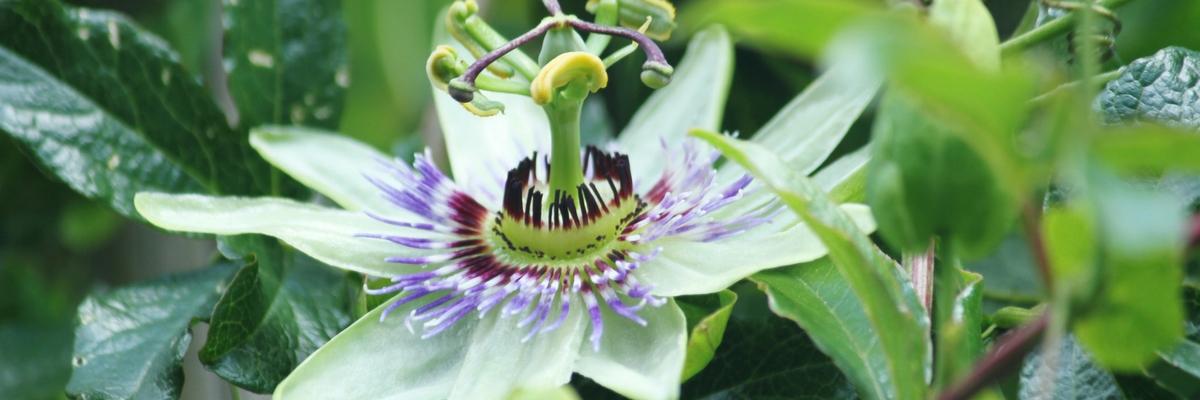
Passion flower: planting, growing, pruning
Contents
Passion flower, in a nutshell
- Passion flower, or passion flower, is a climbing plant with exotic flowering
- It flowers in summer, from June until first frosts, and produces ornamental, even edible, fruits for some species such as Passiflora edulis
- Their hardiness is variable; most species prefer a mild climate
- Passionflowers cling unaided and have the advantage of growing quickly, allowing them to cover wire mesh and pergolas in no time
- Passiflora incarnata is recognised for its sedative properties; leaves and flowers are used in infusions and in homeopathy
A word from our expert
For many of us, Passionflower or “Passion Flower” evokes tropical countries, mysterious scents and fruits with unfamiliar flavours… and that is not far from the truth!
Passionflower, a lush climbing plant, offers magnificent, sophisticated and brightly coloured flowers. It clings using its tendrils located at the axil of its leaves. Its rapid growth makes it ideal for covering trellises, walls or pergolas where it blooms profusely from June to the first frosts.
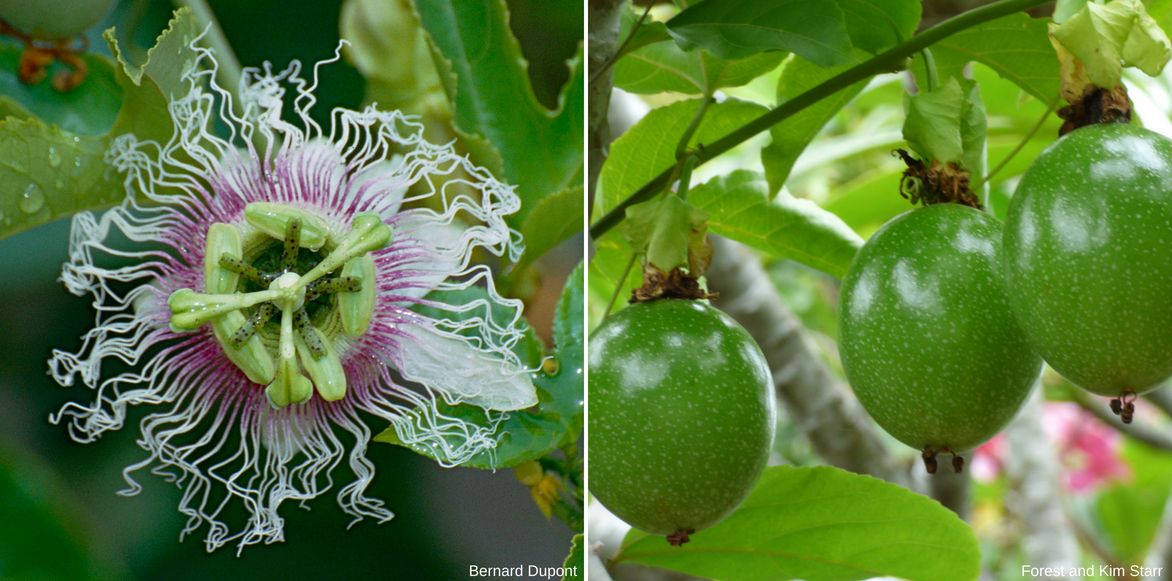
Flower of Passiflora edulis and passion fruits.
Passionflowers range from moderately hardy to frost-tender: plant them in mild climates, in a sunny spot sheltered from cold winds. The hardiest passionflowers are the blue passionflower, Passiflora caerulea, and Passiflora incarnata, a medicinal plant sometimes used in homeopathy. Others are more tender, such as Passiflora edulis, which produces passion fruits, or the superb Passiflora quadrangularis. These more cold-sensitive species should be grown in pots and sheltered in a greenhouse or conservatory over winter.
For a tropical jungle vibe on your terrace or balcony, passionflower is the ideal climbing plant with its large glossy green leaves, striking flowers and unusual fruits. It will easily bring a distinctly exotic feel.
Description and botany
Botanical data
- Latin name Passiflora
- Family Passifloraceae
- Common name passionflower, passion flower
- Flowering June to October
- Height from 5 m to 15 m
- Exposure Sun
- Soil type all, well-drained
- Hardiness frost-tender (min 2°C to 10°C) to moderately hardy (-10°C to -12°C)
Genus Passiflora includes more than 500 species of evergreen or semi-evergreen lianas mostly native to tropical forests of Central and South America, but species are also found in Southeast Asia and on Pacific islands. Passionflowers are grown for their ornamental flowers and juicy-pulp fruits. These are edible but rather insipid in ornamental varieties. They are flavoursome when from Passiflora edulis, P. incarnata and P. alata (commonly called “grenadilla”, “maracujá” or “barbadine”). True passion fruit is produced by species Passiflora edulis.
Passionflower was named by Spanish Jesuits who saw instruments of Christ’s Passion in the flower’s morphology. The flower is therefore symbolic: one can interpret ten apostles (excluding St Peter and Judas) represented by ten tepals, crown of thorns (numerous filaments surrounding the flower centre), three nails (three stigmata), five wounds (five stamens), as well as the whips used for scourging (plant’s tendrils).
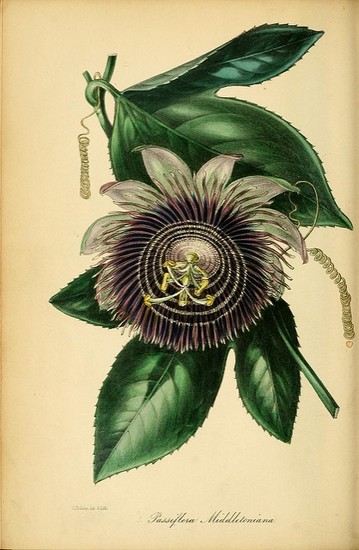
Passiflora edulis – botanical illustration
Passiflora incarnata is a medicinal plant used in herbal medicine. It has sedative and calming properties and is used to combat sleep disorders and anxiety.
Passionflower is a climbing plant that can reach between 5 and 15 m. It attaches itself to supports using tendrils that develop in leaf axils. Passionflower is a vigorous plant that grows very rapidly.
It bears large glossy leaves that reflect the liana’s tropical origin. Leaves are alternate, generally multi-lobed. They may have up to nine lobes and are highly ornamental. Foliage is evergreen or semi-evergreen.
Passionflower blooms in summer, from June to October.
Its simple, very characteristic flowers are positioned in leaf axils. They are generally solitary. Flowers are very large: depending on variety, they measure between 5 and 15 cm in diameter. They consist of five sepals and five petals: since these are similar in shape they are referred to as tepals. At the centre is a pistil that divides into three stigmata (female parts that receive pollen), and five stamens (male parts producing pollen). Compared with other flowers, the stigmata and stamens are unusually large and thick, clearly visible. They are surrounded by a crown of filaments that gives the flower its unique look. These filaments are sometimes undulate, as in Passiflora incarnata. Colours range from bluish-white to pale or deep violet and pink. A few varieties are red (P. quadrangularis, P. alata, P. coccinea).
Passionflower flowers are delicately scented. Some varieties, such as Passiflora ‘Perfume Passion’, have been selected specifically for their pleasant fragrance.

Passionflower, several colours: Passiflora caerulea, Passiflora quadrangularis, Passiflora ‘Constance Elliot’, Passiflora ‘Victoria’, Passiflora ‘Incense’.
At end of summer, ornamental fruits appear like small lanterns hanging from the plant. They are edible (but not always worth eating!), fleshy and ovoid. Size varies between 4 and 6 cm. Skin is smooth and shiny and may be yellow, orange or brown depending on variety. Passiflora edulis is mainly grown for its fruit; fruits of other species are less interesting gastronomically (with exceptions such as Passiflora incarnata). Inside, fruits are filled with pulp and contain numerous seeds. You can collect these for sowing.
At season’s end, the simultaneous presence of last flowers and fruits creates a delightful display.
Graphic shape of the flower, striking foliage and pretty fruits make passionflower an exceptional climber.
Hardiness of passionflowers varies by species, which can be a selection criterion. The hardiest passionflowers include Passiflora incarnata and P. caerulea.

A young plant of Passiflora caerulea, bearing numerous fruits at different stages of ripeness. / Cross-section view of a Passiflora caerulea fruit showing seeds (photo Hubert Berberich)
Read also
Clematis: planting, pruning and careSpecies and varieties
These varieties can be planted outdoors in open ground in mild climate.
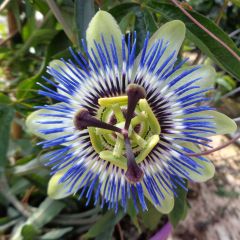
Passiflora caerulea- Passion Flower
- Flowering time July to November
- Height at maturity 7 m
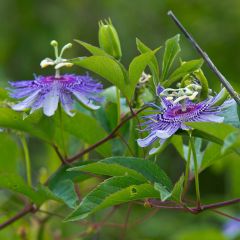
Passiflora incarnata- Passion Flower
- Flowering time August to December
- Height at maturity 3,50 m
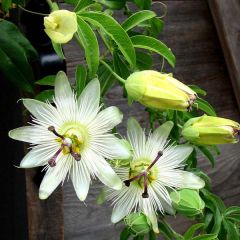
Passiflora caerulea Constance Elliot- Passion Flower
- Flowering time August to October
- Height at maturity 8 m
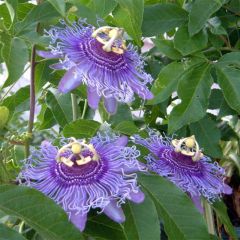
Passiflora Incense- Passion Flower
- Flowering time July to October
- Height at maturity 5 m
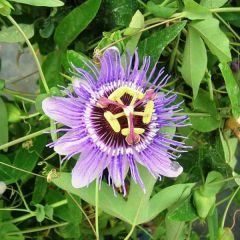
Passiflora caerulea Purple Haze- Passion Flower
- Flowering time July to November
- Height at maturity 4 m
These passion flowers must be protected from cold. You can grow them in a pot and bring indoors in winter, or grow them year‑round under glass, in a conservatory or in an apartment. Growing in open ground can be considered in southern gardens, on Mediterranean coast for example.
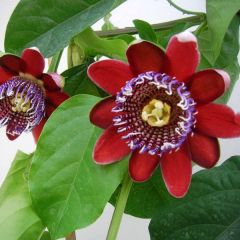
Passiflora alata
- Flowering time July to November
- Height at maturity 5 m
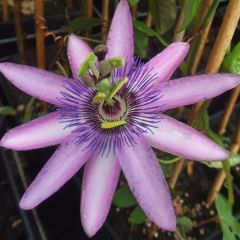
Passiflora Lavender Lady- Passion Flower
- Flowering time July to November
- Height at maturity 6 m
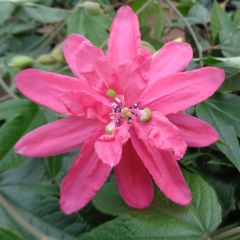
Passiflora Pink Passion- Passion Flower
- Flowering time May to October
- Height at maturity 3 m
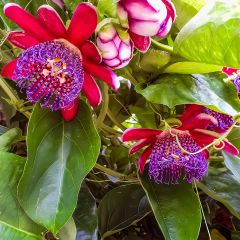
Passiflora quadrangularis
- Flowering time August to November
- Height at maturity 8 m
Discover other Passionflowers
View all →Available in 0 sizes
Available in 0 sizes
Available in 0 sizes
Available in 0 sizes
Available in 1 sizes
Available in 1 sizes
Available in 1 sizes
Available in 1 sizes
Available in 2 sizes
Planting a passion flower
Where to plant passionflower?
If passionflower is frost-sensitive, soil matters little. Indeed, it tolerates wide range of soils: acidic, neutral or alkaline, and also copes with limestone. It nevertheless prefers fertile ground.
Plant preferably in full sun, or possibly in partial shade. For indoor growing, choose bright spot.
Hardiest passionflowers can be planted in ground; but, unless living around Mediterranean basin, we recommend growing in a pot for less hardy varieties! This makes it easy to bring plants indoors in winter, under cover, to protect from cold. You can also grow them in greenhouse or conservatory all year round.
In all cases, choose warm, sunny spot: passionflower will reward you many times over with magnificent flowers and abundant fruit and will quickly cover its support (it can grow up to 4 m per year!). It will be less voluble in dry conditions but just as floriferous. You can plant passionflower against south-facing wall. We also recommend placing it somewhere sheltered from cold winds.
Passionflowers also do well in pots: grown this way, they bring touch of the tropics by trailing over wall or balcony balustrade.
→ Also read our advice in Where is best place to plant passionflower?
When to plant?
Plant passionflower in spring, when risk of frost has passed.
How to plant passionflower?
To plant passionflower in ground, in garden :
- Start by soaking rootball in container of water to hydrate it: this will help plant establish
- Dig hole 2 to 3 times size of rootball
- Place good layer of gravel at bottom of hole
- Remove passionflower from its pot and tease out roots from edge of rootball
- Position plant in centre of hole. Top of rootball (collar) should be level with soil
- Backfill while keeping plant upright and checking collar is not buried
- Firm down with foot and water copiously
- Mulch around base
- Water once or twice a week during first two summers, then only in case of drought
If you choose to grow in a pot :
- Choose container 30–50 cm in diameter
- Add good layer of drainage at bottom (gravel, broken terracotta or clay pebbles)
- Fill with mix made of half garden soil, quarter compost and quarter sand, clay pebbles or pumice. You can also use commercial potting compost, provided it is light and free-draining.
Passion flower care
Passionflowers planted in open ground, outdoors
These are the hardiest, to be grown under a mild climate: Passiflora caerulea, P. incarnata and P. incense.
Undemanding, passionflower requires very little care. As it grows, train this liana onto its support to avoid a straggly appearance.
Remove faded flowers as they appear (but not all, if you want fruit).
In case of drought, once established, only its growth will be slowed. It therefore does not need watering, unless you want it to colonise the area where you planted it.
Passionflower is not a very greedy plant. Nevertheless, an application of organic fertiliser or well-rotted compost in autumn will make your passionflower even more vigorous and prolific.
In preparation for winter, to protect the base from cold, cover it with a 10–15 cm thick layer of mulch.
→ Learn more about Pruning and training passionflower
Passionflowers in pots
For passionflowers grown in pots, the actions are the same: train the liana onto its support and prune to keep it contained.
Do not water too often: let the medium dry out between waterings and, from late autumn to late winter, limit watering to once every two weeks.
In spring, about every two weeks, apply a liquid fertiliser enriched with potassium to encourage flowering.
Growing passionflowers in pots is a good way to get around the low hardiness of some varieties, but remember to bring the more tender ones into a bright, frost-free room before cold weather arrives.
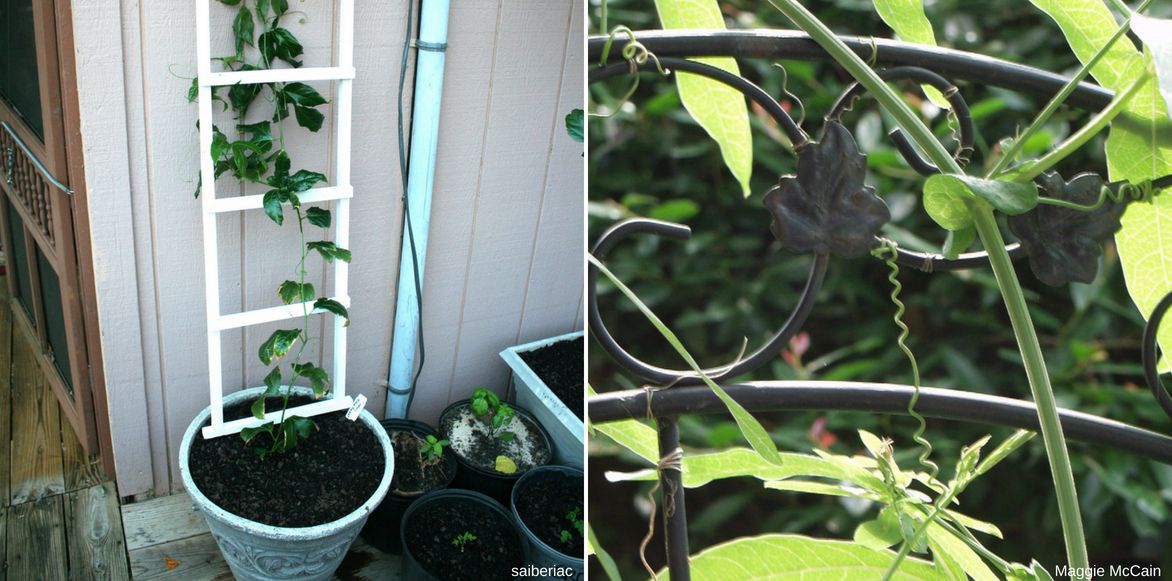
Passionflower grown in a pot – attachment via tendrils.
If you grow your Passionflower at home, mist the leaves occasionally to compensate for the dry atmosphere caused by heating. Check regularly for pests invading your plant and monitor leaf health, as diseases and pests (such as scale insects) proliferate in confined spaces.
Hardiest passionflowers can remain outdoors; however it is wise to:
- Place the pot against a wall sheltered from cold winds
- Mulch the base with a 10–15 cm thick layer of mulch
In case of severe cold:
- Protect the pot. To do this, tie newspaper or horticultural fleece around it. Then wrap it in bubble wrap and finish with a strip of reed matting. This will insulate the roots from frost.
- Wrap the plant in several layers of winter fleece
Pruning passion flower
Regular pruning maintains a harmonious appearance and encourages flowering.
When to prune?
Passionflower is best pruned in spring, but pruning during the season can help contain its growth.
How to prune?
To prune passionflower effectively :
- Start by removing dead, misplaced or surplus stems to maintain a regular habit. In pots, prune more severely: cut back every third or fourth stem to lighten and contain the plant.
- Shorten the longest stems
If frost has damaged the plant, cut burnt stems back near the base: passionflower will regrow from the stump.
You can use pruning to train and reposition the stems on their support.
Possible diseases and parasitic pests
Passionflower has no known diseases, but is susceptible to some parasitic pests. It can suffer attacks from whiteflies (aleurodes) in greenhouse or conservatory. Treat with black soap.
Also watch out for scale insects! Passionflower is susceptible to both mealybugs and shield scale insects. To remove them, you can use a mixture of water, black soap, methylated spirits and vegetable oil. However, if scale insects are few, a cloth soaked in soapy water may suffice.
Passionflowers can also be affected by red spider mites, small mites that suck sap and cause small yellow spots on leaves. As they prefer dry conditions, simply spray water on foliage.
Beware of gastropods at start of growth: spread wood shavings after each rain or use an organic product harmless to predators of slugs and snails (Ferramol).
If your passionflower is in a pot, take preventive action against vine weevils by mulching (to prevent the female from laying eggs) or by spraying a nematode-based solution (organic control).
→ Learn more in our care sheet : passionflower diseases and pests
Sow and propagate passion flower
To multiply this beautiful climber, you can either sow seeds or make cuttings. It is also possible to air-layer it.
Sowing passionflower seeds
Sowing is done in spring or autumn. It is not an easy sowing because the integument is particularly hard. To overcome this difficulty, we recommend rubbing your seeds on sandpaper, which will facilitate germination. You can then place the seeds for 24 hours in lukewarm water.
Fresh seeds, recently harvested, give much better results. If you collect seeds from your own passionflowers, we advise sowing them immediately, as they quickly lose germination capacity. Otherwise, store them in the refrigerator until needed.
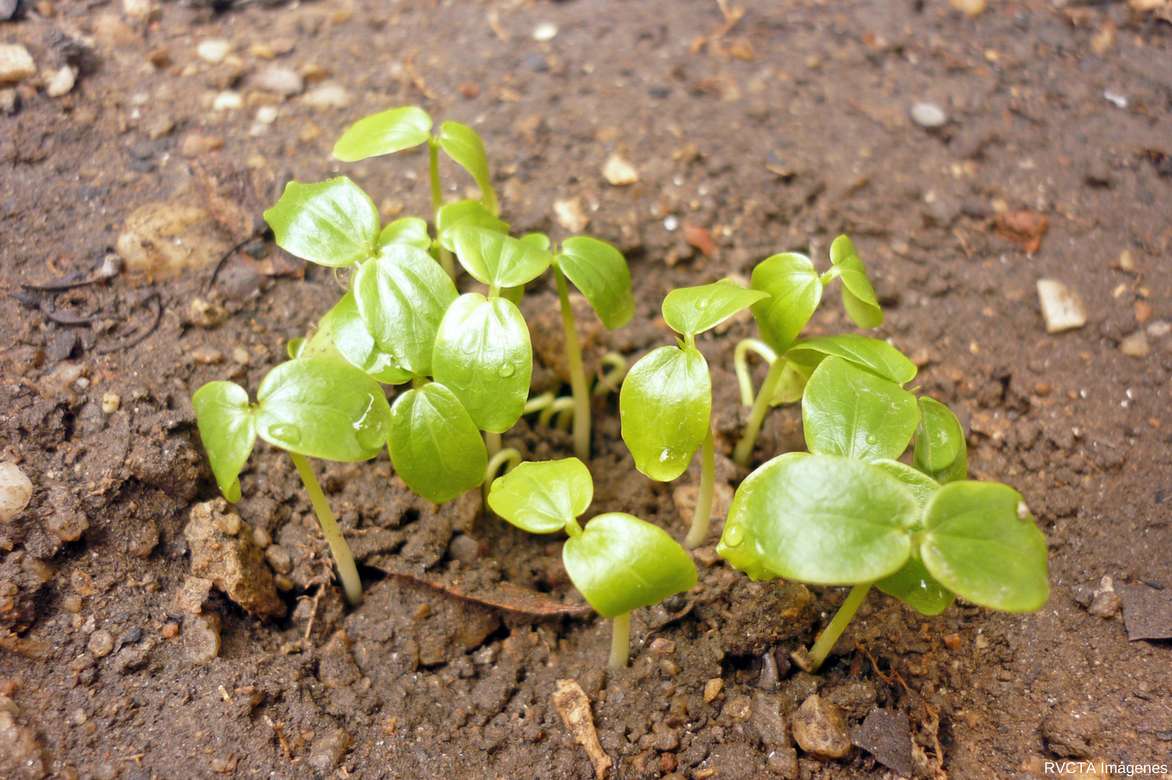
Sowing of Passiflora edulis.
Then sow in a seed tray or bucket, in special sowing compost, and place in a warm, bright spot. Using a heated propagator or a gentle heat source helps speed up germination, which normally takes a few weeks … but can take several months! Do not discard your sowing if seedlings do not appear after several weeks.
Ideal temperature is around 25 °C (preferably cooler at night and warmer by day). We recommend placing a plastic film or a sheet of glass over the pot to retain a humid atmosphere. Ventilate from time to time.
Propagate passionflower by cuttings
Propagation by cuttings from semi-ripe stems (which become woody, hard) is the best method to multiply passionflower.
Proceed as follows :
- From August to September, cut stem sections about 20 cm long, with at least three leaves
- Remove leaves from the base and trim others if necessary
- Dip the base of the stem in plant hormone powder for cuttings and plant the cuttings in a light, well-draining mix (for example half sand, half compost; or special sowing compost)
- Cover with a film, a plastic bag or make a cloche using the top half of a bottle, for example, to create a humid atmosphere; then leave them to root
- Once winter has passed, your cuttings should be rooted: transplant them into individual pots.
Companion planting with passion flower
Passionflower is such a vigorous and distinctive plant that it can be grown on its own against a trellis to form a hedge, for example.
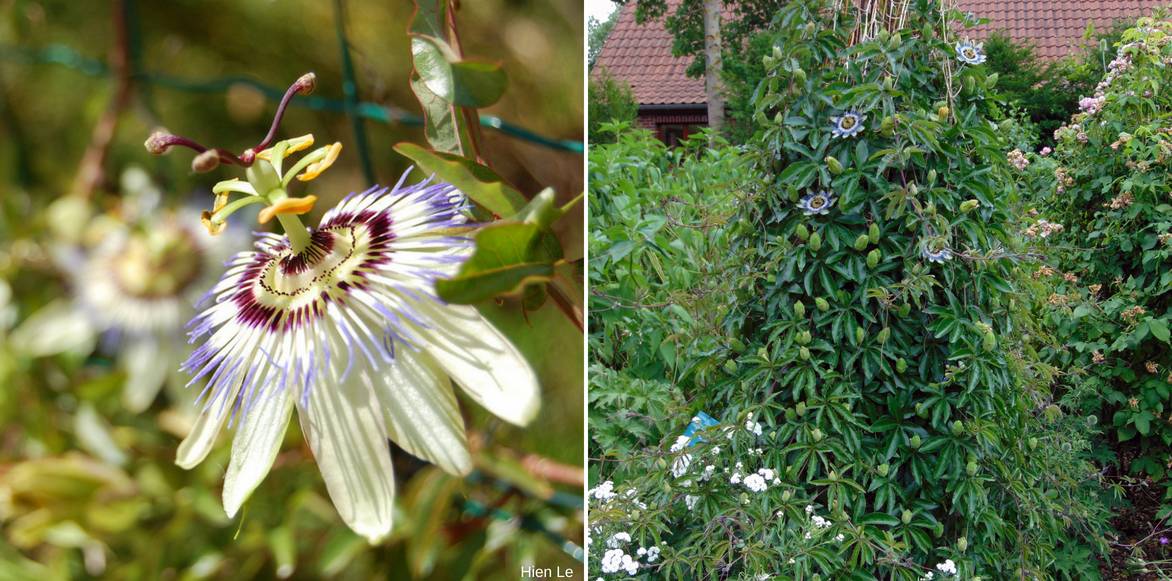
Passionflower can be trained on a trellis or on a tepee.
If you grow it in non-scorching sun, you can pair it with Akebia, another climbing plant with exotic charm. This one flowers a little earlier, in spring, so their flowering periods can follow one another. In addition, Akebia’s very decorative foliage will beautifully accompany your passionflowers! In full sun, a creeping lantana, a tropical plant of similar hardiness, will occupy the base of the passionflower and can trail elegantly from the pot.
In a more classic, traditional garden, don’t hesitate to pair it with one or more clematis. For example, you can choose the passionflower ‘Constance Elliott’ and place it on a pergola or a trellis in the company of clematis with pink or mauve flowers, and a few climbing roses. You’ll achieve a rather delicate and romantic effect.
As passionflower is a liana with a very exotic appearance, offering an impressive and original flowering, you can use it to create a lush garden bringing together surprising plants from afar. Plant beside it species with impressive flowering, such as Eucomis, Kniphofia, Eremurus, Crinum or Hedychiums… Install other lianas, such as Akebias, Bougainvillea, and especially trumpet creepers! These are vigorous climbers, highly decorative both for their divided foliage and for their warm‑coloured flowers. Also favour plants that offer impressive foliage, such as Phormiums, Fatsia japonica, arborescent ferns, Cycas revoluta, banana plants (notably Musa basjoo, the hardiest), Tetrapanax… Your garden will then seem to transform into a true jungle!
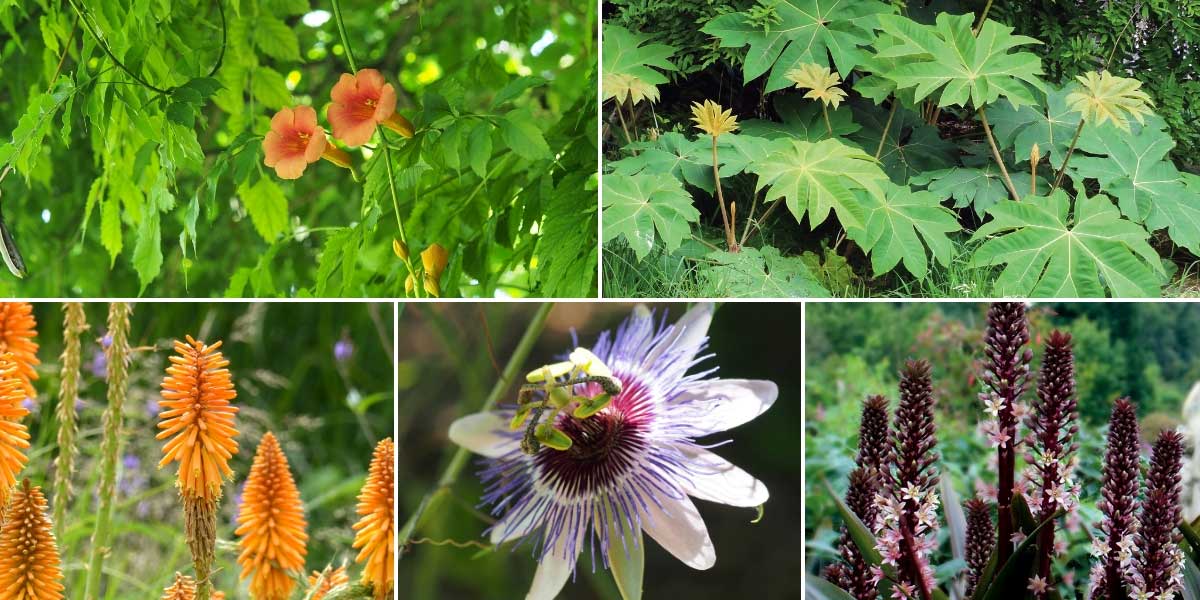
You can integrate passionflower into an exotic-style garden. Campsis radicans (trumpet creeper), Tetrapanax papyrifera ‘Rex’, Kniphofia ‘Fiery Fred’, Passiflora ‘Purple Haze’ and Eucomis ‘Sparkling Rosy’
- Discover our range of passionflowers!
- An article by Ingrid on our blog – 10 exotic and hardy plants for a jungle garden
- Take inspiration from this exotic ambience to pair passionflowers
- Tutorial: How to take passionflower cuttings? Our illustrated tutorial!
- Advice sheet: Choosing a passionflower
- Advice sheet: Passionflower and its benefits
- Our tutorial: Pruning and training passionflower
- Advice sheet: passionflower diseases and pests
- Advice sheet: 6 passionflowers to grow in pots
- Our advice sheets: Which passionflower to plant depending on your region? ; Passionflower — the hardiest ; Passionflower: how to protect it from cold?
- Advice sheets: 5 captivating passionflower varieties to discover ; Most fragrant passionflowers ; Most beautiful white-flowered passionflowers ; Most beautiful red-flowered passionflowers ; 7 pink-flowered passionflowers to beautify the garden
Frequently asked questions
-
Short answer : Yes — but it depends on species and climate.Details and practical tips- Which species to choose : Passiflora edulis (purple or yellow passionfruit) produces the best‑tasting edible fruit. Some hardy species such as Passiflora caerulea survive outdoors in cooler areas but often produce few fruits or fruits of poor flavour.- Climate and location : Outdoor fruit production is realistic in warm, frost‑free parts of France (Mediterranean coast, parts of the Atlantic coast, sheltered microclimates). In central and northern France you will generally need a greenhouse, conservatory or to grow plants in containers that can be moved indoors for winter.- Sun and soil : Plant in full sun or a very sheltered, south‑facing position. Use fertile, well‑drained soil; in containers use a good quality potting mix with regular feeding.- Temperature and season : Passion fruit needs warm summers and a long growing season to set and ripen fruit. Frost will damage flowering wood and reduce harvest; protect from temperatures below about −2 to −3 °C (many edible cultivars need milder winters).- Pollination : Some cultivars are self‑fertile, others need cross‑pollination or specific pollinators (large bees). In cool or greenhouse conditions, hand pollination of flowers with a small brush often increases fruit set.- Care : Provide strong support or trellis for vigorous vines. Water regularly in dry weather, feed with a balanced fertiliser during growth, and prune lightly to control vigour and promote flowering wood. Overwinter tender varieties indoors at cool but frost‑free temperatures.- Harvest : Fruit is ripe when it develops full colour (purple or yellow depending on cultivar) and often when it softens slightly or falls. Store at room temperature to ripen further if needed.- Problems : In cool, damp climates flowers may fail to set, and fungal diseases can be an issue — ensure good air movement and avoid waterlogged soil.Recommendation : For reliable edible fruit in most of France choose Passiflora edulis and grow under glass or in a sheltered, warm site; in Mediterranean and milder Atlantic areas you can often succeed outdoors with correct siting and protection. Hand pollination and winter protection will improve your chances of getting passion fruits.
Passion fruit is produced by species Passiflora edulis. It is not very hardy; unless you grow it under glass, in a warm, bright spot, you are unlikely to enjoy its fruit. Fruits of other passionflowers are edible but much less flavoursome. However, you can try to grow Passiflora incarnata, which is fairly hardy and produces interesting fruits to eat!
-
My passionflower has small, white, cottony clusters.
These are mealybugs, small insects that settle on plants and suck their sap, weakening them. To eliminate them, you can use a compound made from water, black soap, vegetable oil and methylated spirits.
-
Small white flies fly up as soon as I move the plant.
These are whiteflies, small flying insects that usually settle under the leaves and feed on plant sap. As they like heat and dryness, we recommend ventilating and misting the foliage. Also use black soap to get rid of them.
- Subscribe!
- Contents
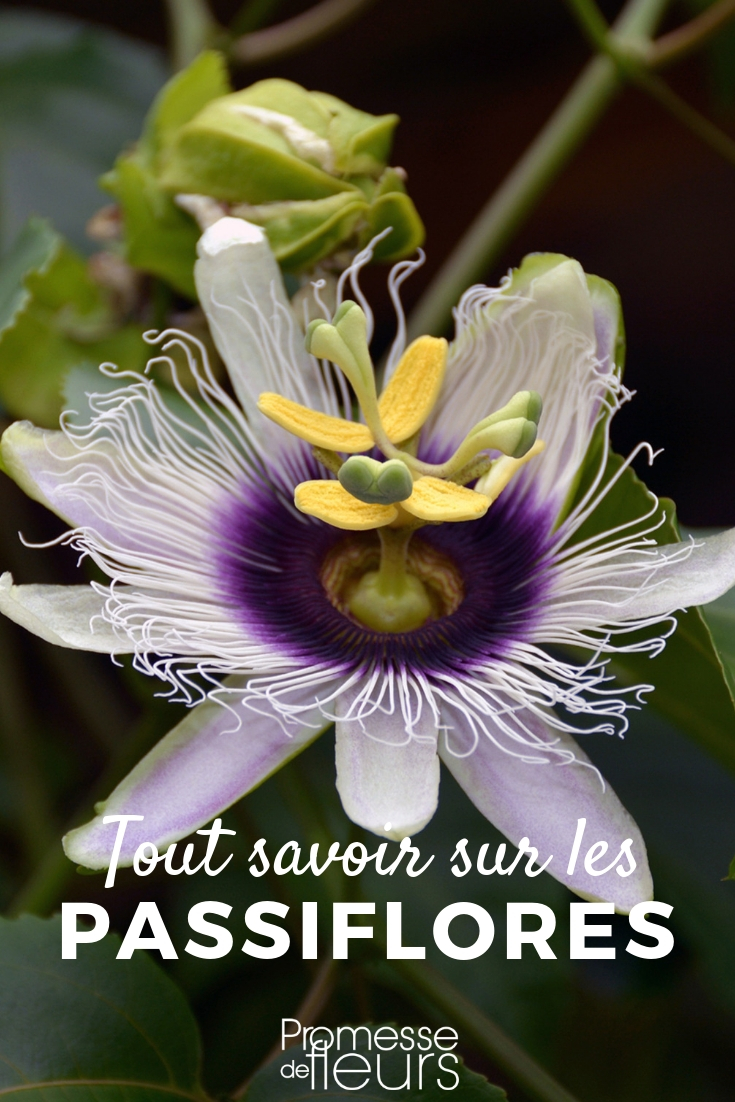































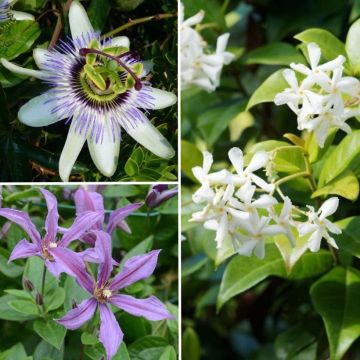
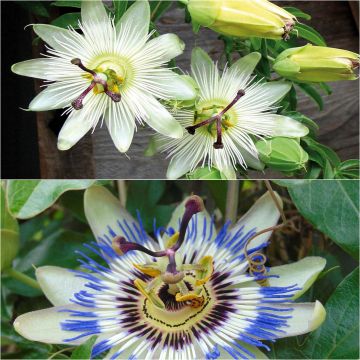
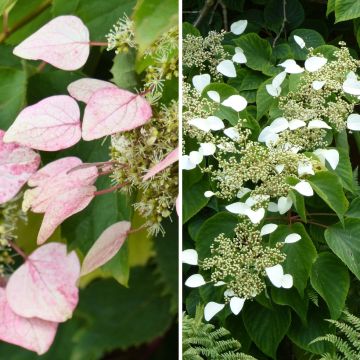
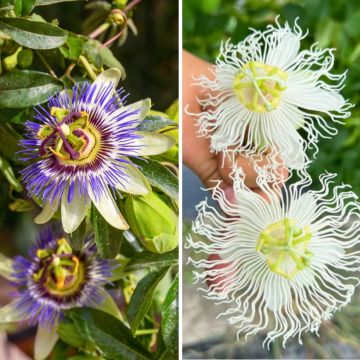
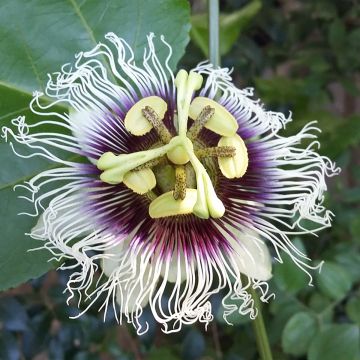

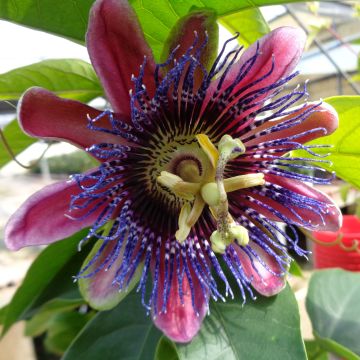

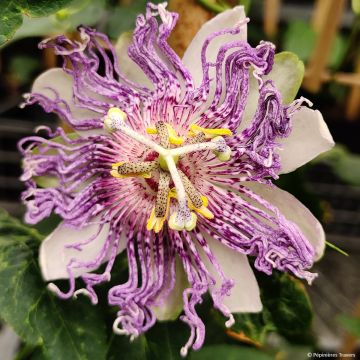
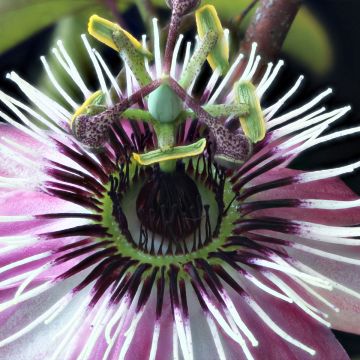
Comments